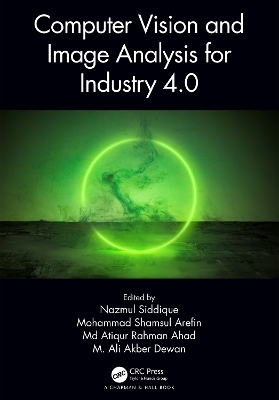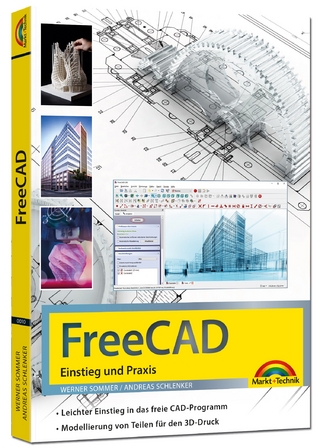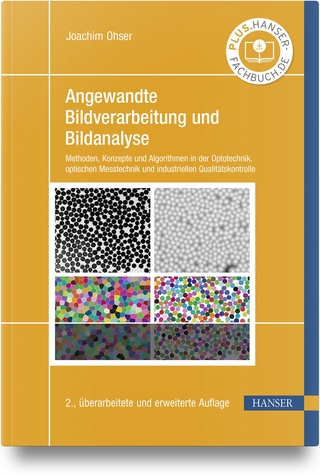
Computer Vision and Image Analysis for Industry 4.0
Chapman & Hall/CRC (Verlag)
978-1-032-16416-8 (ISBN)
Computer vision and image analysis are indispensable components of every automated environment. Modern machine vision and image analysis techniques play key roles in automation and quality assurance. Working environments can be improved significantly if we integrate computer vision and image analysis techniques. The more advancement in innovation and research in computer vision and image processing, the greater the efficiency of machines as well as humans. Computer Vision and Image Analysis for Industry 4.0 focuses on the roles of computer vision and image analysis for 4.0 IR-related technologies. The text proposes a variety of techniques for disease detection and prediction, text recognition and signature verification, image captioning, flood level assessment, crops classifications and fabrication of smart eye-controlled wheelchairs.
Nazmul Siddique is with the School of Computing, Engineering and Intelligent Systems, Ulster University. He obtained Dipl.-Ing. degree in Cybernetics from the Dresden University of Technology, Germany, MSc in Computer Science from Bangladesh University of Engineering and Technology and PhD in Intelligent Control from the Department of Automatic Control and Systems Engineering, University of Sheffield, England. His research interests include: cybernetics, computational intelligence, nature-inspired computing, stochastic systems and vehicular communication. He has published over 170 research papers including five books published by John Wiley, Springer and Taylor Francis. He guest-edited eight special issues of reputed journals on Cybernetic Intelligence, Computational Intelligence, Neural Networks and Robotics. He is on the editorial board of seven international journals including Nature Scientific Research. He is a Fellow of the Higher Education Academy, a senior member of IEEE and member of different committees of IEEE SMC Society and UK-RI Chapter. He was involved in organising many national and international conferences and co-edited seven conference proceedings. Mohammad Shamsul Arefin is in lien from Chittagong University of Engineering and Technology (CUET) and currently affiliated with the Department of Computer Science and Engineering (CSE), Daffodil International University, Bangladesh. Earlier he was the Head of the Department of CSE, CUET. Prof. Arefin received his Doctor of Engineering Degree in Information Engineering from Hiroshima University, Japan with support of the scholarship of MEXT, Japan. As a part of his doctoral research, Dr. Arefin was with IBM Yamato Software Laboratory, Japan. His research includes privacy preserving data publishing and mining, distributed and cloud computing, big data management, multilingual data management, semantic web, object oriented system development and IT for agriculture and environment. Dr. Arefin has more than 120 referred publications in international journals, book series and conference proceedings. He is a senior member of IEEE, Member of ACM, Fellow of IEB and BCS. Dr. Arefin is the Organizing Chair of BIM 2021; TPC Chair, ECCE 2017; Organizing Co-Chair, ECCE 2019; and Organizing Chair, BDML 2020. Dr. Arefin visited Japan, Indonesia, Malaysia, Bhutan, Singapore, South Korea, Egypt, India, Saudi Arabia and China for different professional and social activities. Md Atiqur Rahman Ahad, SMIEEE, SMOSA; Professor, University of Dhaka (DU); Specially Appointed Associate Professor, Osaka University. He studied at the University of Dhaka, University of New South Wales, and Kyushu Institute of Technology. His authored/edited 10 books in Springer, e.g., “IoT-sensor based Activity Recognition”; “Motion History Images for Action Recognition and Understanding”; “Computer Vision and Action Recognition”. He published 180+ journal/conference papers, chapters, 120+ keynote/invited talks, 35+ Awards/Recognitions. He is an Editorial Board Member of Scientific Reports, Nature; Assoc. Editor of Frontiers in Computer Science; Editor of Int. Journal of Affective Engineering; Editor-in-Chief: IJCVSP; Guest-Editor: PRL, Elsevier; JMUI, Springer; JHE, Hindawi; IJICIC; Member: ACM, IAPR. M. Ali Akber Dewan, Member, IEEE received the B.Sc. degree in computer science and engineering from Khulna University, Bangladesh, in 2003, and the Ph.D. degree in computer engineering from Kyung Hee University, South Korea, in 2009. From 2003 to 2008, he was also a Lecturer with the Department of Computer Science and Engineering, Chittagong University of Engineering and Technology, Bangladesh, where he was an Assistant Professor, in 2009. From 2009 to 2012, he was a Postdoctoral Researcher with Concordia University, Montreal, QC, Canada. From 2012 to 2014, he was a Research Associate with the ť Ecole de Technologie Supťerieure, Montreal. He is currently an Assistant Professor with the School of Computing and Information Systems, Athabasca University, Canada. He has published more than 50 articles in high impact journals and conference proceedings. His research interests include artificial intelligence, affective computing, computer vision, data mining, information visualization, machine learning, biometric recognition, medical image analysis, and health informatics. He has served as an editorial board member, a Chair/Co-Chair and a TPC member in several prestigious journals and conferences. He received the Dean’s Award and the Excellent Research Achievement Award for his excellent academic performance and research achievements during his Ph.D. studies in South Korea.
A Benchmark Dataset for Document Level Offline Bangla Handwritten Text Recognition (HTR) and Line Segmentation. 2. A New Approach Using Convolutional Neural Network for Crops and Weeds Classification. 3. Lemon Fruits Detection and Instance Segmentation Under Orchard Environment Using Mask R-CNN and YOLOv5. 4. A Deep Learning Approach in Detailed Fingerprint Identification. 5. Probing Skin Lesions and Performing Classification of Skin Cancer Using Efficient Net while Resolving Class Imbalance Using SMOTE. 6. Advanced Grad CAM: Improved Visual Explanations of CNN’s decision in Diabetic Retinopathy. 7. Bangla Sign Language Recognition Using Concatenated BDSL Network. 8. Chest Xray Net: A Multi-class Deep Convolutional Neural Networks for Detecting Abnormalities in Chest X-Ray Images. 9. Achieving Human Level Performance on the Original Omniglot Challenge. 10. A Real-Time Classification Model for Bengali Character Recognition in Air-Writing. 11. A Deep Learning Approach for Covid-19 Detection in Chest X-Rays. 12. Automatic Image Captioning Using Deep Learning. 13. A Convolutional Neural Network Based Approach to Recognize Bangla Handwritten Characters. 14. Flood Region Detection Based on K-Means Algorithm and Color Probability. 15. Fabrication of Smart Eye Controlled Wheelchair for Disabled Person.
| Erscheinungsdatum | 11.07.2023 |
|---|---|
| Zusatzinfo | 110 Line drawings, black and white; 110 Illustrations, black and white |
| Sprache | englisch |
| Maße | 178 x 254 mm |
| Gewicht | 548 g |
| Themenwelt | Informatik ► Grafik / Design ► Digitale Bildverarbeitung |
| Informatik ► Theorie / Studium ► Künstliche Intelligenz / Robotik | |
| Mathematik / Informatik ► Informatik ► Web / Internet | |
| Technik ► Elektrotechnik / Energietechnik | |
| ISBN-10 | 1-032-16416-6 / 1032164166 |
| ISBN-13 | 978-1-032-16416-8 / 9781032164168 |
| Zustand | Neuware |
| Informationen gemäß Produktsicherheitsverordnung (GPSR) | |
| Haben Sie eine Frage zum Produkt? |
aus dem Bereich


